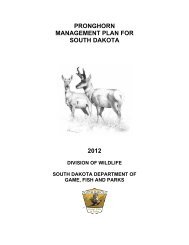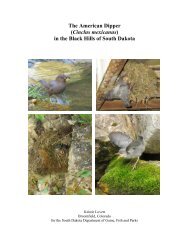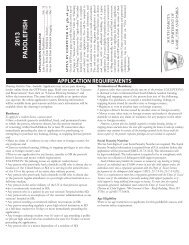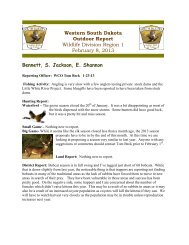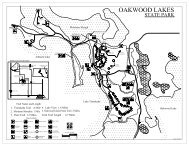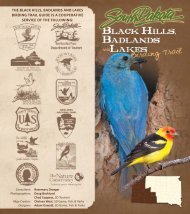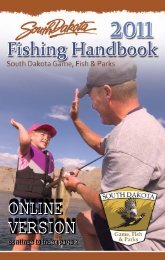pdf version - South Dakota Department of Game, Fish and Parks
pdf version - South Dakota Department of Game, Fish and Parks
pdf version - South Dakota Department of Game, Fish and Parks
Create successful ePaper yourself
Turn your PDF publications into a flip-book with our unique Google optimized e-Paper software.
EEL (family Anguillidae)<br />
American Eel<br />
Anguilla rostrata<br />
Quick key characteristics: The American eel is found in cool- <strong>and</strong> warmwater<br />
habitats. It has a s<strong>of</strong>t, elongate caudal fi n that is continuous with dorsal<br />
<strong>and</strong> anal fi ns, but lacks pelvic fi ns. It has a forward-facing mouth with the<br />
lower jaw protruding in front <strong>of</strong> the upper, <strong>and</strong> its body shape is elongated<br />
<strong>and</strong> tubular, giving it the appearance <strong>of</strong> a snake. It appears scaleless, but has<br />
small scales embedded in its skin.<br />
Similar species in <strong>South</strong> <strong>Dakota</strong>: silver lamprey, burbot<br />
Identifi cation: The American eel is more elongate than burbot <strong>and</strong> lacks a<br />
chin barbel <strong>and</strong> pelvic fi ns. Presence <strong>of</strong> jaws <strong>and</strong> pectoral fi ns distinguish it<br />
from the silver lamprey.<br />
Range: The American eel spawns in the Sargasso Sea <strong>of</strong> the Atlantic Ocean.<br />
Females may migrate far inl<strong>and</strong> via rivers that empty into the Atlantic <strong>and</strong><br />
Gulf <strong>of</strong> Mexico coasts. Movement up the Mississippi <strong>and</strong> Missouri rivers is<br />
impeded by dams, so the species is now rare in <strong>South</strong> <strong>Dakota</strong> <strong>and</strong> only found<br />
in the Missouri River <strong>and</strong> tributaries downstream from Gavin’s Point Dam<br />
<strong>and</strong> in the Minnesota River drainage.<br />
Items <strong>of</strong> interest:<br />
• Feeds on living <strong>and</strong> dead animals <strong>of</strong> all kinds<br />
• Mostly nocturnal<br />
• May travel short distances across l<strong>and</strong><br />
in moist conditions<br />
• Adults that return to Sargasso Sea<br />
from freshwater die after spawning<br />
• Females may reach 70 in., but males<br />
are much smaller<br />
17








